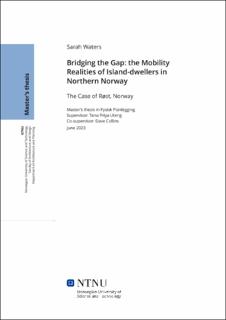| dc.contributor.advisor | Priya Uteng, Tanu | |
| dc.contributor.advisor | Collins, Dave | |
| dc.contributor.author | Waters, Sarah | |
| dc.date.accessioned | 2023-10-05T17:20:32Z | |
| dc.date.available | 2023-10-05T17:20:32Z | |
| dc.date.issued | 2023 | |
| dc.identifier | no.ntnu:inspera:146714540:93413910 | |
| dc.identifier.uri | https://hdl.handle.net/11250/3094604 | |
| dc.description.abstract | Denne oppgaven utforsker mobiliteten til innbyggerne i små øysamfunn i Nord-Norge, med Røst i Nordland fylke som caseområdet. Studien tar sikte på å adressere utfordringene knyttet til transport og mobilitet som bidrar til fraflytting og en aldrende befolkning i distriktene. Undersøkelsen av mobiltetsbehovene til beboere, spesielt ungdom og eldre, har som mål å foreslå løsninger for å dempe mobilitetsutfordringer og øke bo- og «bli»-lyst i små øysamfunn og distriktsområder.
Det overordnede forskingsspørsmålet er derfor: hva er mobilitetssituasjonen i øysamfunnene i Nord-Norge, i lys av eksisterende begrensninger, utviklende teknologier og moderne utfordringer? Slike utfordringer og begrensninger inkluderer, blant annet, fraflytting, COVID-19 pandemien og klimaendringer. Del-forskningsspørsmålene fokuserer på de lokale effektene av den nasjonale gratisfergepolitikken som ble innført sommeren 2022, samt potensialet for alternative og inkluderende mobilitetsløsninger i forskningsområdet.
Ved å bruke en mixed-methods tilnærming, som inkluderer en reisevaneundersøkelse, cyber-forskning, intervjuer og fokusgrupper, avdekker studien et komplekst og unikt nettverk av mobilitet på Røst. Funnen inkluderer en viss bilavhengighet for lokale reiser til tross for relativt korte avstander, sesongvariasjoner i reisevaner og bruk av sosial kapital og frivillige skyssordninger for å kompensere for mangel på drosje og et kollektivtransporttilbud i samfunnet. Videre indikerer funnene at mobiliteten til innbyggerne på Røst er i stadig utvikling, påvirket av samfunns- og teknologiske endringer.
Funnene diskuteres i lys av relevant litteratur og «The New Mobilities Paradigm» som er et viktig konseptuelt rammeverk for denne avhandlingen. Basert på funnene og påfølgende analyser, gis det anbefalinger for å forbedre sosiale og fysiske utviklingspolitikker, samt transportplaner på ulike nivåer. Konklusjonen besvarer forskningsspørsmålene og gir forslag til fremtidige forskningsområder. | |
| dc.description.abstract | This thesis explores the mobilities of residents of small island communities in Northern Norway, with Røst in Nordland County as the chosen case study area. The study focuses on addressing the challenges related to transportation and mobility that contribute to rural depopulation and disproportionate aging in these areas. By investigating the mobility needs of residents, particularly youth and older adults, the research aims to propose solutions to alleviate these challenges and enhance the appeal of small island communities as desirable locations for living, working, and retiring.
The main research question is therefore: how are constellations of mobility shaping up in the island communities of the north of Norway in light of existing constraints, evolving technologies, and modern challenges? Such challenges and constraints include but are not limited to: rural to urban migration, the COVID-19 pandemic, and climate changes. Sub-research questions focus on the local effects of a national free-ferry policy implemented in the summer of 2022, and on the existence of and potential for alternative inclusive mobility solutions in the case area.
Using a mixed-methods approach, including a travel behavior survey, cyber-research, and in-person interviews and focus groups, the study uncovers a complex and unique web of mobilities in Røst. Findings include a noticeable reliance on cars for local trips despite relatively short distances, seasonal variations in travel habits, and reliance on social capital and volunteer-based ride-giving services to fill the gaps left by a lack of taxi and public transportation services. Additionally, findings indicate that the mobilities of Røst residents are constantly changing, shaped by societal changes and evolving technologies.
Findings are discussed in the context of related literature, the identified research gap, and The New Mobilities Paradigm, which serves as the conceptual framework for this thesis. Based on these findings and subsequent analysis, recommendations are given for refining social and physical development policies, and transport plans at various levels. In the conclusion, the research questions are answered and possible avenues for further research are suggested. | |
| dc.language | eng | |
| dc.publisher | NTNU | |
| dc.title | Bridging the Gap: the Mobility Realities of Island-dwellers in Northern Norway
The Case of Røst, Norway | |
| dc.type | Master thesis | |
